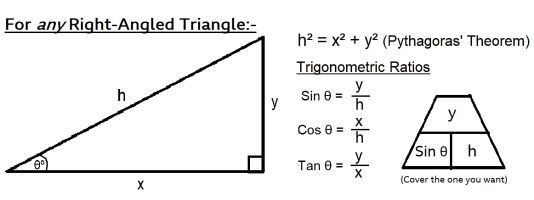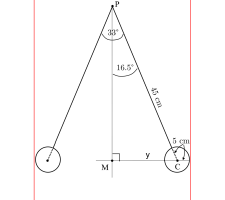Please help with this. I'm strugglingThe pendulum of a grandfather clock consists of a circular disc of radius 5cm attached to a straight length 45cm. If it swings through and angle of 33 degrees, what is the minimum width of the body of the clock?
You are using an out of date browser. It may not display this or other websites correctly.
You should upgrade or use an alternative browser.
You should upgrade or use an alternative browser.
The pendulum of a grandfather clock consists of a circular disc of radius 5cm attached to a straight length 45cm.
- Thread starter Ryland
- Start date
- Joined
- Feb 4, 2004
- Messages
- 16,583
Please help with this. I'm struggling
I have split your question from the other student's seven-year-old thread. But, in that thread, you saw that we need to see your efforts so far, before we can know how to begin helping. You also saw some instructions/helps there.
Please reply with a clear listing of your thoughts and efforts so far, both on your own and after having read the other thread. Thank you!
The Highlander
Full Member
- Joined
- Feb 18, 2022
- Messages
- 937
Have you got an answer for this yet or have you just lost interest?The pendulum of a grandfather clock consists of a circular disc of radius 5cm attached to a straight length 45cm. If it swings through and angle of 33 degrees, what is the minimum width of the body of the clock?
Here is a diagram that (almost) follows the directions given above which illustrates the pendulum at the fullest extent of its swing in both directions...
If you haven't done so you should make your own copy/sketch of this and then follow the advice given below...
Assuming that the pendulum pivots 33° about the point P which lies on the mid-line of the clock's body then the distance PC will be 50 cm, ie: 45 cm + 5 cm. The point M, also lying on the mid-line, will, therefore, be y cm horizontally away from the point C (the centre of the disc) thus creating a right-angled triangle as shown in the diagram.
The red lines indicate the minimum width of the interior of the clock body (although, in practice, a small clearance would need to be added so that the disc does not actually hit the walls of the clock body) and you can calculate the distance MC (y) using Basic Right-Angled Triangle Trigonometry (see below) and, thence, the distance from M to the wall (ie: y + 5).
Please now come back and show us your (own) sketch & working and the final answer you get for the minimum internal width of the clock's body.
Thank you.
You can find y using this ...

Hope that helps.

